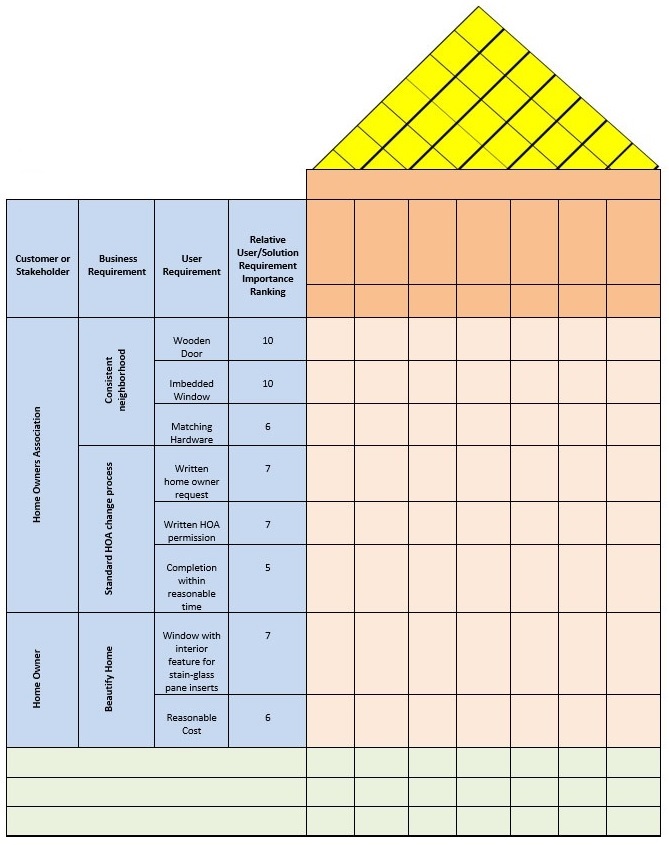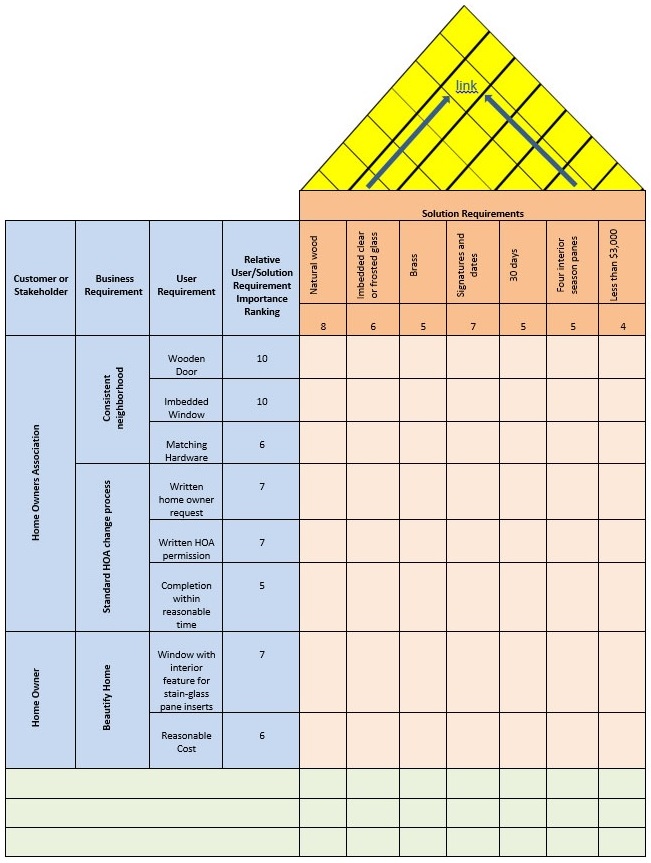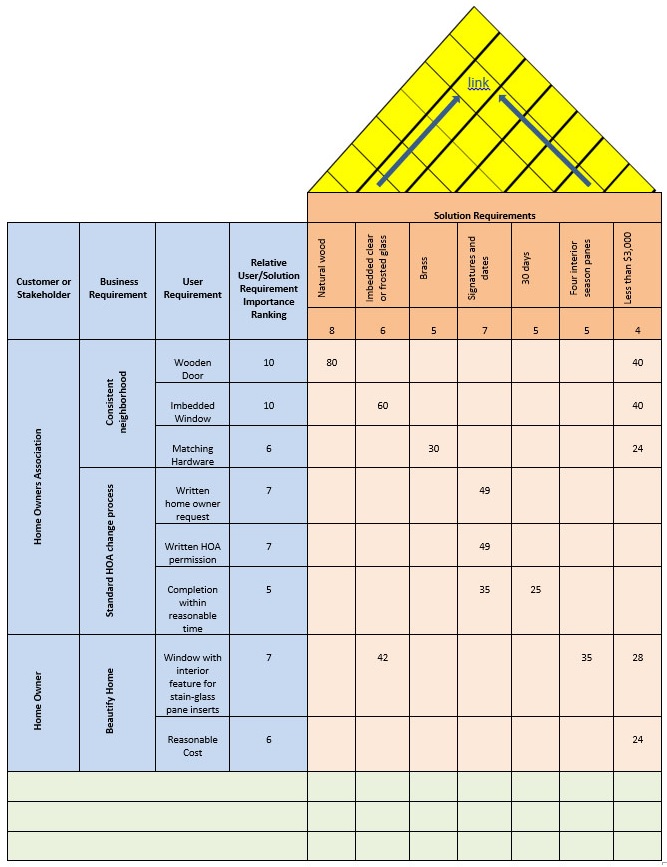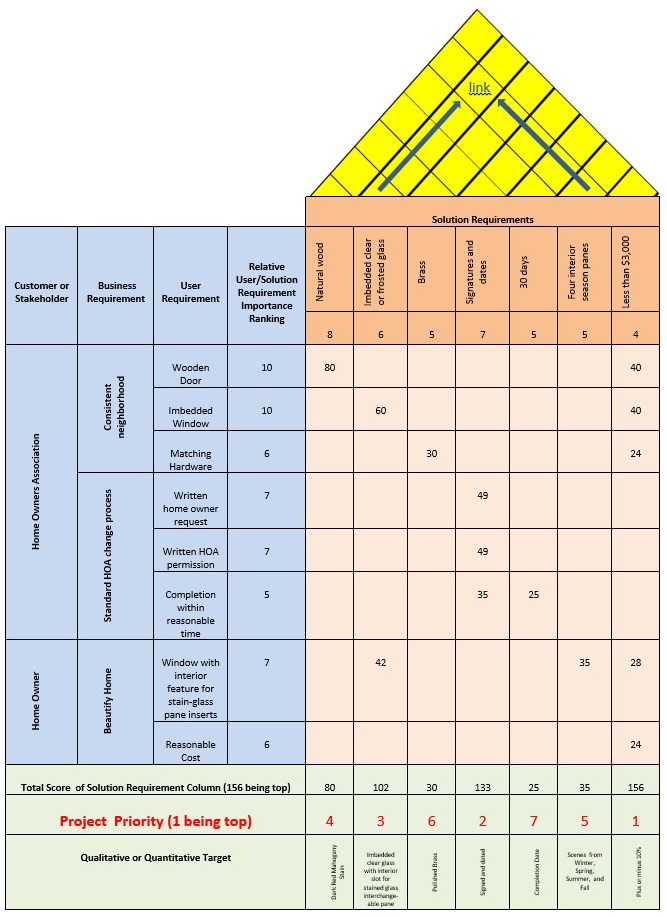This article discusses a tool for documenting, categorizing, ranking and decomposing various types of requirements (business/user and solution). The tool is a derivative from the Quality Function Deployment [1] (QFD, e.g., House of Quality) developed by Dr. Yoji Akao. The business analyst (BA) can use this tool to capture high-level business and user requirements and then decompose them into solution requirements. In fact, the tool can be used multiple times and results strung together to provide forward and backward traceability of requirements through specification and test cases. In addition, this article cites affinity and comparative ranking techniques for grouping and prioritizing requirements respectively.
Quality Function Deployment
The House of Quality consists of six parts:
- Business and User Requirements along with Relative Importance Ranking (House Left Wall – section 1 in figure 1)
- Solution (product and/or service) Requirements with Relative Importance Ranking (House Top Wall – section 2 in figure 1)
- Correlations (positive/negative) or Dependencies of Linked Solution Requirements (House Roof – section 3 in figure 1)
- Traceability linking Business/User Requirement to Solution Requirements and the Calculated Requirements Score (House Floor – section 4 in figure 1)
- Targets in the Form of Expected Qualified and Quantified Metrics plus Project Priority (House Bottom Wall – section 5 in figure 1)
- Competition Matrix (House Right Wall – section 6 in figure 1) – not used in this article’s “front door” example since there is no competition involved
I sequenced the six parts as the BA typically builds the House. The graphic picture (figure 1) provides an unfolded viewpoint of the house laying flat. Note the BA does not have to use all parts. There are several versions of the House of Quality on the Internet depending on the project.
Eliciting the Voice of the Customer
Regardless of what solution development life cycle (SDLC, e.g., agile, waterfall, or some form of hybrid), the business analyst (BA) must document business requirements and decompose them to a form that can be clearly interpreted by a technical developer. Note I stated that BAs document the business requirements – not determine. It’s the customer or stakeholder who determines business requirements. The BA elicits these business requirements via interviews and/or facilitated meetings with the customers. Through these interactions, the BA documents the voice of the customer (business requirements).

Figure 1. House of Quality (numbers represent each component in the above text)
Voice of the Customer (simple example – using sections 1-2)
By conducting various elicitation techniques, the BA documents a list of business requirements. For the purpose of this article, I will use a home project: replacing a front-door of a home. In this case, the customer is the home owner with one additional stakeholder, the Home Owner Association (HOA). Some individuals may consider the HOA a regulatory agency; in this case, I placed it in the category of stakeholder. The BA elicited the following business and user requirements; note the BA used affinity and ranking techniques to group and order the requirements respectively.
- Home Owners Association (HOA)
- Business Requirements – two affinity groups
- Must conform to the neighborhood (HOA agreement)
- Wooden Door
- Window with clear and/or frosted glass
- Matching Hardware
- Must follow HOA process
- Written home owner request
- Written HOA permission
- Complete within reasonable time
- Home Owner
- User Requirements – one affinity group
- Beautify the home
- Window with interior feature for stained-glass pane insert
- Reasonable cost
The BA places these business/user requirements in section 1 of the House of Quality (figure 2).
Voice of the Solution
With section 1 complete, the BA needs to decompose the user requirements into solution requirements. The BA may use brainstorming and/or functional decomposition sessions to identify the solution requirements. Using the same ranking technique, the BA then completes section 2 of the House of Quality (see Figure 3).
Linking Solution Requirements with Correlations and Business/User with Solution requirements
With both section 1 and 2 complete, the BA first links any common solution Requirements in section 3. In this example, there is only one correlation: imbedded clear or frosted glass and four interior season panes (see Figure 4). This common link is the key to satisfy both the HOA and the Home Owner. After the common links are identified in section 3, the BA finds the intersecting cells between the business/user and solution requirements in section 4 of the House and calculates (business/user rank multiplied by the solution rank) the requirements score (see Figure 4). Note that only intersecting cells will have scores and that there can be multiple intersecting cells with scores for any requirement. If the BA cannot find any intersecting cell, there is initial traceability missing or possible scope creep due to requirement changes (i.e., missing a requirement from sections 1 or 2).
Targets
With all the requirement scores complete, the BA sums up the scores in each solution requirements column and places the total in section 4. Using the highest to the lowest total scores, the BA determines the project priority order for the solution requirements (1 being the highest). Needless to say, priorities are vital for every project, but what is also just as vital are qualitative and quantitative measures that indicate that the solution requirement is, in fact, fulfilled. The last row provides those measures.

Figure 2. House of Quality with Business/User Requirements (section 1). Ranking is 10 through 1; 10 being the Top Rank

Figure 3. House of Quality adding Solution Requirements (section 2). Ranking is 10 through 1; 10 being the Top Rank.

Figure 4. House of Quality adding Correlation or Dependencies (section 3). Note the “link” between the Solution Requirements: Imbedding clear or frosted glass and Four interior season panes.

Figure 5. House of Quality adding Traceability and Requirements Score (section 3).

Figure 6. House of Quality adding Targets (section 5).
Summary
This article provides a requirement’s decomposing, ranking, measuring, and tracing tool based on QFD. Note as I have in this article, the BA may customize the House of Quality adding specific rows and columns (e.g., competition products – section 6 in figure 1); several templates are available on the Internet. Also the BA, along with a technical team, can build a traceability complex of Houses (see figure 7 and 8) by transiting section 2 to section 1 of the next house.

Figure 7. House Transition
If, for example, the project is the development of software:
- House A – Business/User Requirements vs. Solution Requirements (functional, nonfunctional, transitional)
- House B – Solution Requirements vs. Technical Specifications
- Alternate House B – Solution Requirements vs. Use Cases
- Alternate House B – Use Cases vs. Test Scenarios
- House C – Technical Specifications vs. Test Scenarios
- House D – Test Scenarios vs. Test Cases
- House E – Test Cases vs. Business Rules (case inputs)
Note the complex provides both intra-House and inter-House traceability.

Figure 8. Traceability Housing Complex
 Author: Mr. Monteleone holds a B.S. in physics and an M.S. in computing science from Texas A&M University. He is certified as a Project Management Professional (PMP®) by the Project Management Institute (PMI®), a Certified Business Analysis Professional (CBAP®) by the International Institute of Business Analysis (IIBA®), a Certified ScrumMaster (CSM) and Certified Scrum Product Owner (CSPO) by the Scrum Alliance. He holds an Advanced Master’s Certificate in Project Management (GWCPM®) and a Business Analyst Certification (GWCBA®) from George Washington University School of Business. Mark is also a member of the Association for the Advancement of Cost Engineering (AACE) International and the International Association of Facilitators (IAF).
Author: Mr. Monteleone holds a B.S. in physics and an M.S. in computing science from Texas A&M University. He is certified as a Project Management Professional (PMP®) by the Project Management Institute (PMI®), a Certified Business Analysis Professional (CBAP®) by the International Institute of Business Analysis (IIBA®), a Certified ScrumMaster (CSM) and Certified Scrum Product Owner (CSPO) by the Scrum Alliance. He holds an Advanced Master’s Certificate in Project Management (GWCPM®) and a Business Analyst Certification (GWCBA®) from George Washington University School of Business. Mark is also a member of the Association for the Advancement of Cost Engineering (AACE) International and the International Association of Facilitators (IAF).
Mark is the President of Monteleone Consulting, LLC and author of the book, The 20 Minute Business Analyst: a collection of short articles, humorous stories, and quick reference cards for the busy analyst. He can be contacted via – www.baquickref.com.
References
- Akao, Yoji (1994). "Development History of Quality Function Deployment". The Customer Driven Approach to Quality Planning and Deployment. Minato, Tokyo 107 Japan: Asian Productivity Organization. p. 339.